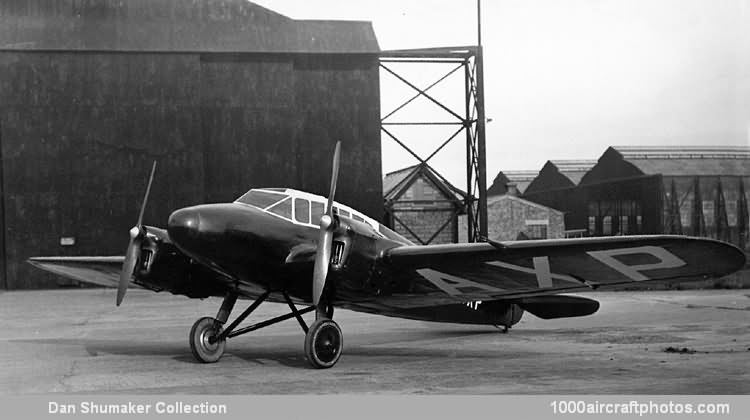None knew better than he the economies in power and the improvement in performance that result from careful streamlining. Thus in a biplane age with several of the longest lived and most widely used of our classic biplane types yet unbuilt, the machine was revolutionary with its streamlined fuselage and cantilever wing into which two inverted engines were faired. Only the crudity of its cabin glazing and the narrow-track landing gear would today reveal its true age.
The machine was known as the Segrave Meteor, detailed design and construction being entrusted to Saunders-Roe Ltd. (often referred to as Saro) at East Cowes, Isle of Wight, by the Aircraft Development Corporation, of which Sir Henry was technical director. Powered by two 120 hp de Havilland Gipsy III engines, the all-white prototype, G-AAXP, made its first flight at Cowes on July 28, 1930, its mixed parentage leading to the official designation Saro-Segrave Meteor appearing on the CofR.
The Blackburn Aeroplane and Motor Co. Ltd., Brough, East Yorks, then took over production, translating the original wooden fuselage into an all-metal stressed-skin version, the revised machine being known as the Blackburn-Segrave Meteor and later as the Blackburn Segrave. Further development and construction was seriously retarded by the tragic death of Sir Henry Segrave in the accident to the speedboat 'Miss England II on Lake Windermere on June 13, 1930. Two Blackburn Segraves G-ABFP and G-ABFR made their appearance in 1931, while a third, G-ABZJ, remained half completed.
The famous 1929 Schneider Trophy pilots, Flight-Lieutenants R.L.R. Atcherley and G.H. Stainforth, formed the crew of the prototype G-AAXP in the 1930 King's Cup Race. Engine trouble prevented the 'dark horse', now red, from showing its paces, and it limped back to Hanworth, the starting point. Later the same year it was flown to Italy by T. Neville Stack for demonstration at the request of the Italian Air Force. There it was flown by the late General Balbo, its performance exciting enthusiastic comment.
In 1932 it was acquired by J.G.D. Armour, a prominent Hanworth private owner, who used it for Continental and other touring, thus fulfilling the purpose of its design. The new owner also raced it for the 1932 King's Cup, but ill-luck again dogged the machine, a forced landing at Filton with a broken petrol pipe putting it out of the race. Nevertheless the course was completed at an average speed of 131.00 mph (210.82 kmh).
G-ABFP, first of the metal-fuselaged Segraves, also red, was delivered at Heston for the private use of Gordon Selfridge in March 1931 and flown by him on the Easter tour of Spain. In the following year the British Air Navigation Co. Ltd. of Heston acquired it for cross-Channel and other charter work, but in 1933 it went to Redhill under the private ownership of Mrs. F.S. Burnside until disposed of to Aircraft Exchange and Mart Ltd. in November 1933.
The sister machine, G-ABFR, was exhibited at the Hendon SBAC Show in July 1932, but was seen no more in the south for some years, being employed on the Brough-Waltham (Grimsby) ferry across the Humber. Like its comrade, it went to Redhill, becoming the property of the Redhill Flying Club Ltd. in May 1936, spares being obtained by cannibalization of the prototype, pieces of which were still in evidence in 1947.
An interesting design exercise into the rigidity of single-spar cantilever wings was carried out with the third airframe. A unique all-metal structure, with a circular-section Duralumin tubular spar, being designed by F. Duncanson of the Blackburn staff. This Duncanson wing was more tapered than the original, part of the hollow spar housing the fuel. The 260 lb. in weight thus saved permitted the installation of Gipsy Major engines and the provision of a fifth seat in the cabin without increasing the all-up weight. Markedly different from a standard Segrave, the machine was reregistered and flew in silver and black as G-ACMI early in 1934.
No others were built, and G-ACMI was used for experimental flying at Brough. Data thus gained led to the construction of the Blackburn H.S.T. 10 transport, which had the Duncanson wing, a retractable landing gear and two Napier Rapier engines. Military commitments forced the company to abandon its development, and after the prototype had appeared under B conditions as B-9, it was given to Loughborough College as an instructional airframe."
